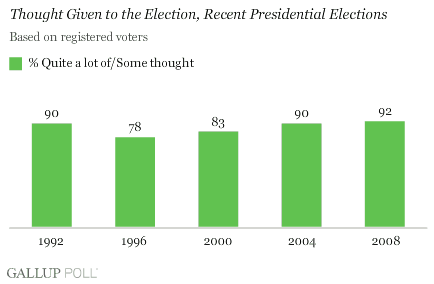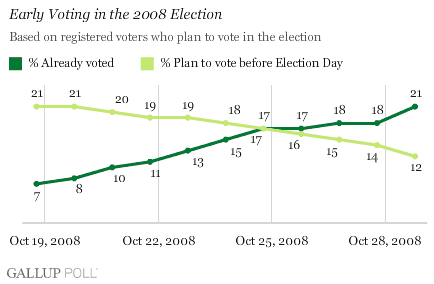PRINCETON, NJ -- At this stage in the election process, some four days before Nov. 4, Gallup reviews and updates several key indicators relating to voter turnout in this year's election.
1. Attention Being Paid to the Election
A Gallup Poll conducted Oct. 23-26 found 92% of registered voters saying they had given quite a lot or some thought to the election. This is a classic measure of interest in the election that Gallup has been tracking for decades, and the current reading is one of the highest such percentages found prior to an election in recent Gallup history.
There were similarly high attention levels in 1992 and 2004, which turned out to be higher-turnout elections. The campaigns of 1996 and 2000 captured significantly lower levels of voter attention, and were also lower-turnout elections. The high reading on this measure in 2008, perhaps not surprisingly, suggests a high-turnout election again this year.

2. Early Voting
Gallup's latest update -- based on interviewing conducted through Wednesday, Oct. 29 -- shows that 21% of registered voters who plan to vote say they have already voted early or by absentee ballot. This percentage has been increasing steadily over the last two weeks. Another 12% of registered voters say they still plan on voting early, leaving about two-thirds of those who plan on voting who indicate they will actually vote on Election Day itself, next Tuesday.

These early voters are more likely to say they have voted for Barack Obama than for John McCain, by a 55% to 40% margin. Among those who plan to vote on Election Day, the spread is much closer -- only a 48% to 45% Obama advantage.
Despite some perceptions that there may be disproportionate early voting among blacks, Gallup's data show that black voters and white voters are roughly proportionate in their reports of already having voted.
There does, however, continue to be a significant age skew in the early voting patterns, such that older voters are significantly more likely than those who are younger to report having already voted.
3. First-Time Voters
Eleven percent of registered voters interviewed by Gallup this week claim to be first-time voters, which is similar to the percentage recorded in 2004 (13%). Most of these voters are under age 30, and, as is the case for this demographic group in general, they tend to be strongly oriented toward voting for Obama, according to their self-reported vote intentions.
But an important question is how many of these first-time voters will actually end up voting? Gallup's traditional likely voter model estimates that 8% of the electorate will be first-time voters (even though this model is based partly on past voting behavior, first-time voters are not penalized if they were too young to vote in past elections, and if they report already having voted, they also qualify as likely voters). In an expanded model, which does not rely on past voting experience to predict turnout in the coming election, they represent a slightly higher 10% of the electorate.
4. Voter Mobilization Efforts
Gallup has been asking Americans whether they have been contacted by the Obama campaign and by the McCain campaign. Thus far, the Obama campaign appears to have a modest edge in terms of voter contact and get-out-the-vote efforts. Gallup's updated estimate is that about 37% of registered voters say the Obama campaign has contacted them, while 30% say the McCain campaign has done so. Both numbers are likely to grow in the coming few days, as much of the mobilization is likely to occur in the final weekend and final days of the election.
The contact rates have tended to be higher for those residing in battleground states.
Survey Methods
Results for thought given to the election are based on telephone interviews with 1,010 national adults, aged 18 and older, conducted Oct. 23-26, 2008. For results based on the total sample of national adults, one can say with 95% confidence that the maximum margin of sampling error is ±3 percentage points.
Results for the other questions are based on interviews drawn from Gallup Poll daily tracking, consisting of approximately 3,000 or more interviews each. These results have a maximum margin of sampling error of ±2 percentage points.
Interviews are conducted with respondents on land-line telephones (for respondents with a land-line telephone) and cellular phones (for respondents who are cell-phone only).
In addition to sampling error, question wording and practical difficulties in conducting surveys can introduce error or bias into the findings of public opinion polls.
